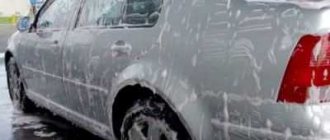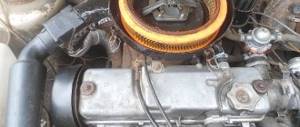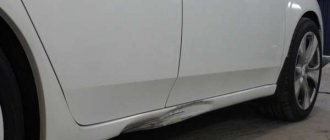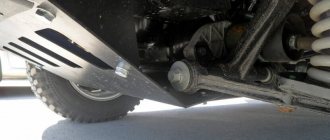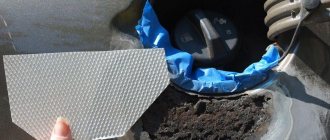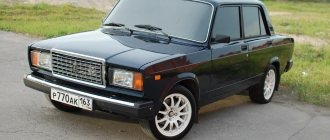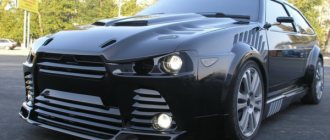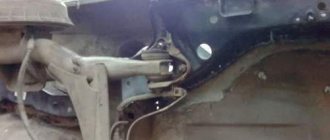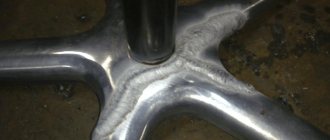The car body is constantly exposed to negative external factors: road reagents, moisture, dirt. The problem is aggravated by vibration loads. Even with proper care, traces of rust, holes, and cracks appear on surfaces. Welding a car helps eliminate these shortcomings with your own hands. The method is not suitable for removing large defects.
You need to be very careful when welding a car.
Precautions before welding
Working with the device involves some risks, so the technician must follow the following rules:
- Welding is performed in boxes with screens that protect the eyes from light radiation. The minimum screen height is 150 cm.
- When working in a garage, the elimination of body defects begins after ventilation and turning on the forced exhaust.
- When welding in rooms with high humidity, a rubber suit and a mat will protect workers from electric shock. When working in a lying or sitting position, add felt.
- Before starting welding, inspect the cable and other important components of the apparatus. Only high-quality equipment and consumables are used for work.
- When welding the body, the mass of the battery is first removed, which eliminates accidental fire. When repairing parts located near the gas tank, the latter is dismantled.
- The semi-automatic device can only be moved when it is turned off. During a break, the equipment is placed on a dielectric stand.
We are considering whether it is possible to weld a car body with a welding inverter
If we talk about whether it is possible to weld a car body with a welding inverter, there are several important points to consider. One of the most important conditions for high-quality welding work on the body is not even the inverter itself, but the master who will use it. Despite all the additional functions of a welding inverter that facilitate welding work, a beginner will not be able to do this either with a semi-automatic device or with an inverter. What is the complexity of the work?
- First of all, this is the thin thickness of the metal. Due to the thinness of the body iron, semi-automatic welding machines are often used for welding work.
- The second factor that will have to be taken into account is the creation of microcracks that appear under the influence of electric current on the surface of the body.
Taking into account both nuances, it is easy to conclude that you can weld a car using inverter welding, but this must be done taking into account the characteristics of the metal and the work technique.
How to choose a welding inverter for a garage
As already described above, you can weld a car body with a welding inverter if you have experience and practice, and a more uniform voltage supply will significantly improve the final result of the work. Experienced craftsmen note that for novice welders, the choice of an inverter installation is optimal. When choosing a welding inverter for welding a body car, you should pay attention to the following characteristics:
- Surge protection level. The presence of a voltage drop control function is mandatory, but for high-quality models that are suitable for work in the garage, this coefficient will be 20-25%.
- Temperature range at which welding work is possible. A European manufacturer usually produces equipment based on its standard EN 60974-1; in the Russian Federation, GOST IEC 60974-1-2004 applies. If the installation is as advertised, it is capable of operating in the range from -40° to +40°C. But it’s even better to clarify these standards in the manufacturer’s operating instructions.
- Performance characteristics. A car inverter for body welding will have to operate at almost minimum power. It is necessary to select an installation taking into account the work with electrode No. 2 (two). This is required so as not to burn through the thin steel of the body. If we take into account that welding a car with an inverter may also include other work with metals of greater thickness, it becomes clear that the choice should be made on a machine with the ability to work with electrodes No. 4.
- Additional functions - you should not pay attention to this criterion. Some manufacturers are trying to attract the attention of potential buyers with “hot start”, “anti-stick electrode” and similar functions. In fact, a car welding inverter, or rather its operating principle, is due to the fact that it has all these capabilities. Any model, regardless of manufacturer, will have them by default.
It is best to store an inverter welding machine for a garage not in the room itself, especially if it is not heated, but at home. A large number of microcircuits that are included in the installation device are afraid of dampness and sudden temperature changes.
How to weld a car using inverter welding
To learn how to weld a car using inverter welding, you will need knowledge and understanding of at least the basics of welding. It is not without reason that experts recommend using inverter models for beginners and experienced craftsmen. An inverter welder is capable of operating at low current, ensuring a uniform supply of voltage to the arc. As a result, the amount of spatter during welding is reduced. A conventional welding machine and inverter welding for body work differ only in the principle of applying voltage to the electrode and the metal being processed, while the work carried out with their help is practically no different from each other. There are a few simple rules:
- If the metal is burned through, the wrong welding current is selected, it is necessary to reduce it.
- Some metals are welded by reversing the polarity. In this case, the plus is brought to the surface being treated.
Before starting work, it is necessary to warm up the electrode. To do this, you need to run the electrode over a smooth metal surface.
Requirements for the inverter and safety when welding the body
There are several basic requirements for the safe operation of the installation itself when welding body parts, and for the worker. Safety regulations can also significantly influence the choice of the appropriate model. Namely:
- Safety - the worker must be confident that he will not be exposed to electrical current. It is for this reason that you should pay attention to the safety class of the inverter device. It is prohibited to carry out work outdoors during rain.
- Availability of short circuit protection. The system must have a function to automatically stop the power supply in case of an emergency.
- Overheat protection. Although welding of body iron with an inverter will be performed at low power, the overheating control unit will avoid equipment failure.
- Protection from moisture and dust. During operation, a large amount of dust accumulates inside the case, so it is necessary to clean it from time to time. For a garage, it is better to choose a welding inverter that has an automatic dust removal function.
Even an inverter installation with a high level of moisture protection should not be stored in a damp area, especially if it is not planned to be used for a long time.
Although semi-automatic installations are usually used for welding car body parts in most cases, inverter welders can also be used.
stroy-plys.ru
How to prepare a car for restoration
Before body repair, perform the following steps:
- Metal stripping. You can only cook parts from which traces of paint and rust have been completely removed. It is also necessary to dismantle elements that complicate repair work.
- Treating the affected areas with automotive primer. Particular attention is paid to the edges of the defect. This method of metal preparation is used with caution. Excess composition on the surface leads to rapid melting or combustion of the material.
- Removing moisture from surfaces. The presence of water droplets negatively affects the quality of the seam, contributing to the formation of voids.
Subtleties of body welding
To eliminate defects you need a high-quality welding machine . The workplace is equipped with a grounded outlet that can withstand the connection of powerful equipment. The master must have sufficient experience, because thin metal elements are more difficult to connect than thicker parts. It is impossible to say exactly which welding is best for welding a car body. The method is selected taking into account the type of defect and the location of its occurrence.
Welding a car body has its own subtleties.
The most common are:
- work in argon environment;
- manual welding;
- joining parts using a semi-automatic machine.
Thresholds and fenders are most often cooked using the spot method. Power components are repaired through installation and overlap welding. The butt method is used when replacing faulty parts.
Car body welding and repair features
The body of almost any modern car can be in active use for 10-15 years, before the onset of active corrosion processes. Of course, this is possible in the case of high-quality care and absence of damage (and if there is any, with high-quality repairs). However, the need for repair work using welding may be required not only when corrosion develops, but also, for example, as a result of an accident. Let's look at the technologies for carrying out various types of work so that the reader can imagine how possible it is to weld a car body with your own hands.
How the body is welded at the factory
As you know, the finished body is not cast at all, but a number of parts are stamped from tin, which are then welded together into a single body. Of course, the process occurs, in most cases, automatically, using robots. However, the technology itself is very different from what can be seen in car repair shops or in factories working with metal structures.
The typical welding method, where the weld is laid, has a number of disadvantages, such as:
- The difficulty of laying the seam itself;
- The need to take into account the “conduction” of the metal - after all, during operation it becomes very locally heated, which causes uneven thermal expansion and its deformation;
- Significant consumption of additional materials (electrodes, wire, etc.).
At car factories, the technology for welding a car body is significantly different - they mainly use spot welding. This is a fairly simple method that allows you to practically eliminate consumables, increase the accuracy of positioning of parts in automatic flow production and neutralize the negative effect of local thermal expansion.
The technology itself is quite simple - two parts are positioned, and the future weld point is compressed by two non-consumable electrodes, through which a significant current is passed. Two layers of tin at the point of contact are reliably soldered to each other. In this case, there is no weld, the geometry of the parts is not lost and the possibility of spring deformation is created, which has a positive effect on durability.
Of course, this type of connection does not provide for a sealed seam, but this can be solved by applying a special sealant to the contacting areas. And the body itself, after the work, is completely painted. This is how such strong and aesthetic connections are obtained that can be seen on any car of a standard design.
How to weld and repair a body in a car service center or garage
You can find workshops where they use similar factory welding technologies, but every year it becomes more and more difficult. The fact is that when carrying out repair work using spot welding, not only appropriate equipment is required, but also the use of many additional materials. And repairing, for example, a hole (using spot welding) can be quite problematic. Therefore, other methods of joining metal elements dominate in repair work.
Article on the topic: Methods for carrying out protective polishing of a car body at home.
Semi-automatic
This is the most common type of equipment for welding work on a car. Its popularity is ensured by its ease of use - after all, you can simply “crawl” into any corner and make a seam. It does not require very strong knowledge and experience.
Technically, the semi-automatic welding machine is quite simple - it uses almost the same current converter as the others. But the consumables differ. The main consumables are welding wire of various diameters (from 0.2mm to 2mm), usually coated with a layer of copper, and carbon dioxide. The copper layer is necessary for good electrical contact and as a flux. Carbon dioxide supplied to the welding arc area prevents atmospheric oxygen from coming into contact with the molten metal.
Unlike conventional welding machines, in a semi-automatic machine not only the current strength is regulated, but also the feed speed of the welding wire, which allows you to adjust it quite accurately. With this device you can make thin, almost invisible seams, with sufficient joint strength.
To use carbon dioxide, you need not only the filled cylinder itself, but also a reducer that will reduce the pressure (150 atmospheres is a lot for any type of control equipment). And its flow also needs to be adjusted to get the most optimal value.
If you are afraid of the need to use carbon dioxide, then you can use a special wire, which, although not coated on the outside with a copper layer, contains a special flux inside that allows you to carry out work without supplying gas. Ordinary wire, in this case, simply burns - it is impossible to weld with it without gas.
Thanks to the above features, as well as the ability to simulate spot welding, semi-automatic welding of a car body has become so popular in workshops, both at the official level and in garage-level services, as well as among private owners.
Inverter
Inverters have become extremely popular recently, despite the fact that they are simply a further development of ordinary welding machines, but with modern components. The main difference between the inverter comes down to the method of current conversion - in it, unlike standard ones (where mains 50 Hz are used), the conversion frequency is much higher (approximately 30-40 kHz).
Thanks to this innovation, it was possible to make a welding machine of fairly small size and light weight. However, it is not very sensitive to low supply voltage, and the arc ignites very easily. In fact, you need to try not to ignite it - even the most inexperienced beginner can cope with the inverter.
Related article: Restorative polishing of a car body. Advice from professionals.
The welding process itself involves the use of electrodes, completely similar to standard welding. Although welding a car body with an inverter is simple, the results are far from ideal. The seam is not even enough, but it is quite thick. Heating of the metal around occurs more intensely, which may cause thermal deformations.
But if you need to weld a place that is invisible to the eye (for example, on the bottom), then you can use this option.
Useful tips
If you decide to carry out welding work yourself, and have already decided which welding to use to weld the car body, but you don’t yet have much experience behind you, then it’s worth knowing a few nuances.
Regardless of the type of welding machine (with the exception of spot welding), if a long weld is expected, then it is necessary to proceed in several stages. First, the part to be welded must be “grabbed” in several places so that it is securely fixed. Then you should make several short (1-2 cm) seams along the connection line. After each operation, the metal must cool down. And only as the final stage is to make the final connection. This will reduce temperature deformations to a minimum.
Anti-corrosion
When welding work is caused by corrosive destruction of the body, the rust must be removed, otherwise the repair will not last long (thanks to the tricks of oxidation of iron, which can be divalent or trivalent). Those. It is necessary to remove damaged areas and clean traces of rust down to metal.
After the work is completed, the weld also needs to be protected, because if it remains “as is”, it will quickly be destroyed. And if this process almost always occurs on the front part of the part, then the internal part is often “forgotten”, especially when it is located in a closed cavity.
That is why it is not uncommon for rust to break through the paint along the weld after a year. Moreover, in the described case, it will no longer be possible to get rid of it with cosmetics - a complete remodeling is necessary. When there is access from both sides, there are no problems.
However, what to do when the inside of the weld is in a closed cavity? In this case, it is better to partially sacrifice the integrity by drilling a hole into the cavity, which will allow the cavity to be treated with anti-corrosion agent.
Thus, the completed welding of the car body will not only please the eye, but will also last for quite a long time. And the rest is up to you.
What types of welding are used for machines
To repair the body or underbody at home, manual technology is used. However, the seams obtained using this method are rough. There is a high probability of burning through or deformation of thin metal. This method is not recommended for repairing visible parts of the car.
High-quality welding is performed by a semi-automatic unit.
It is used to weld parts less than 1 mm thick. When replacing the active gas with an inert gas, it becomes possible to connect elements made of aluminum or stainless steel. When choosing a welding technology, preference is given to the semi-automatic method.
Car welding instructions
The procedure for restoring the body or other parts of the car depends on the chosen method.
Using the Electrode
This method is used in the absence of high requirements for the aesthetic qualities of the seam . Choosing the right electrode for the type of metal helps ensure a strong connection. It is recommended to use inverter equipment that supports a stable arc. The reliability of the weld depends little on the experience of the welder.
To reduce the likelihood of joint deformation, welding work is performed in the following sequence:
- Create potholders.
- Apply short stitches in 5 cm increments.
- Weld the part with a continuous seam.
After each step, take a short break to allow the metal to cool. Welding thick automotive parts can take 3-5 hours. Forced cooling is prohibited: it greatly reduces the strength of the connection.
Semi-automatic device
To weld with such a unit, you will need copper-plated wire with a diameter of 1 mm, coarse sandpaper, a gearbox, and carbon dioxide.
The work is carried out as follows:
- The edges treated with abrasive material are installed as close to each other as possible. For fixation, self-tapping screws, bolts, and clamps are used.
- Set the required current strength and supply speed of the consumable material using the regulators located on the device body.
- The gas cylinder is equipped with a reducer and a hose. Unscrew the nozzle and remove the tip from the burner.
- Install a coil of wire into the apparatus. The free end is inserted into the feed mechanism. Place the tip on the wire and return the nozzle to its place.
- The polarity is set: the holder is connected to the plus, the burner to the minus. The opposite option is installed when using wire that is not coated with copper.
- Connect the unit to the electrical network. The burner is brought to the area to be treated. Press the button to start the supply of gas and filler material. To form a long seam, you need to weld 3-4 points. Next, stitches 2-4 cm long are made.
- Wait for the metal to cool, weld the distances between the tacks.
SAIPA-165
Inverter Features
The popularity of such devices is explained by their compact size, low power consumption, the use of new current conversion technologies, and an expanded range of modes. The unit can operate in a wide range of input voltages. The arc is excited quickly and burns stably.
Many people starting work for the first time wonder whether it is possible to cook a car with an inverter. The process is not much different from standard welding, but the seam is of lower quality - uneven, thick.
The metal overheats, which can cause it to become deformed. Inverter technology is used to repair hidden places, such as the bottom.
How to cook a car body with an inverter
When purchasing a used vehicle, you need to carefully examine it for various deficiencies. In this matter, any minor nuances are important, since in the future they can result in big problems. When choosing a car, many potential buyers pay attention only to the technical characteristics, condition of the engine, transmission, chassis and other related elements that set the car in motion. Accordingly, due attention is not paid to checking the newness and integrity of the body, although the condition of this part of the vehicle is also of paramount importance.
Experts note that the body of cars produced by the domestic auto industry can have its original characteristics for up to 10 years of active use, after which it begins to wear out and rot. Imported cars are more durable in this regard; their body can last up to 15 years. This is due to the high quality of the metal used in the production of car bodies.
METHOD OF WELDING A BODY WITH AN INVERTER
Today, owners of such SUVs most often turn to car repair shops to create additional frames, bull slats, rear and front winches, as well as fog lights located on the roof of the vehicle. The main advantage of this method is the high speed, thanks to which you can complete all the work in the shortest possible time . The inverter has been used to create welds on car bodies since Soviet times. It is used mainly for the domestic UAZ-469 SUV, the body of which is not so demanding in terms of aesthetic appearance. For a domestic SUV, the first place is the reliability and strength of all components, which includes the body.
To increase the speed of work and increase the reliability of fastening with an inverter, it is these parts that need to be welded.
Inverter welding relies on the creation of high-frequency electric current. Most often, equipment of this type is quite bulky, but more expensive devices boast portability and small dimensions. At the same time, the quality of welds created by inverter machines practically does not depend on the person. Such equipment can be easily mastered in a few hours. But this type of welding has its disadvantages:
- high price;
- inability to create welds on metal with a thickness of more than 3 mm;
- malfunctions due to moisture and dust entering the housing.
Experts recommend purchasing a device with a medium to high cost, since the cheapest models are considered unreliable. Another advantage of inverter welding is the ability to operate at low voltage in the electrical network. It should be remembered that when working with welding equipment of this type, safety regulations must be observed.
As a rule, Russian factories produced low-quality bodies for cars such as VAZ-2101, 2108, 2106, 2109, 2107 until 1994. After the 10-year period, the rotting process affected most of the body metal. This is due to the wrong approach to car painting. Simply put, the car body had not been primed at all before.
Nowadays on the used vehicle market you rarely find models that have not undergone changes since those times. Most of them were reconstructed using semi-automatic welding, which is best suited for patching affected areas of the body of domestic cars.
A semi-automatic welding machine creates a connection using a special wire. It is considered the most versatile body metal welding tool available today. The semi-automatic machine is designed for welding metal with a thickness of 0.8-6 mm.
It is used in the following types of work:
- creating a reliable connection on the side members;
- creating patches in areas susceptible to corrosion;
- straightening emergency dents.
The semi-automatic device operates on the principle of supplying pressure using carbon dioxide from a special cylinder. During the feeding process, oxygen is gradually displaced, which protects the treated area from oxidation. The welding procedure with this type of equipment involves gradual melting of the metal structure of the body. Since this process is regulated, the possibility of iron combustion is completely eliminated.
The advantage of a semi-automatic machine is the ability to create a connection on any type of metal. If carbon dioxide is replaced with argon, it becomes possible to weld non-ferrous metals, which include aluminum and stainless steel. To create a reliable connection, it is recommended to weld an area of 2 cm with seams at intervals of 5 cm. Before starting work, the area to be treated must be primed in accordance with all the rules of this process.
RECOMMENDATIONS FOR WELDING A CAR BODY WITH YOUR OWN HANDS
Independent welding of thin-layer metal is a rather labor-intensive process. This will require the necessary experience creating welds on metal sheets and the ability to identify areas that need welding.
First of all, it is necessary to thoroughly inspect the body of the machine and analyze the affected areas. This will allow you to decide what kind of repair the car needs, which can be local or major.
Overhaul involves extensive work associated with replacing specific sections of the body, and local repair involves the creation of reliable patches in some of its places. If you have the necessary experience with welding equipment, you can handle both types of repairs. Without the required skills, it is recommended to try patching only partial areas that are susceptible to corrosion.
When the body rots in not very noticeable areas, various types of materials can be used as a patch. The main requirement in this case is similarity in thickness and high reliability.
rulikolesa.ru
Body finishing
After completion of electric welding, perform the following steps:
- Clean welded joints from slag. This reduces the likelihood of oxidation of metal elements. To treat hidden places, use an iron brush. Open areas are sanded with a grinder and a special wheel. A sander with a burr is suitable for cleaning hard-to-reach areas.
- Degrease treated surfaces by wiping them with solvent. After this, the parts are coated with an anti-corrosion agent or acid primer. The best option is epoxy putty, which protects surfaces from moisture and air. It aligns the welded joint. The composition is applied in a thin layer and left for a day. You cannot dry the putty with a hairdryer.
- Re-treat the surfaces with sandpaper. Apply the second and third layers of putty. Prepare the body for painting.
Seam sealant for cars is used to protect connections in hidden places. It is leveled and painted. The sealant is applied using a pneumatic sprayer with a plastic nozzle.
